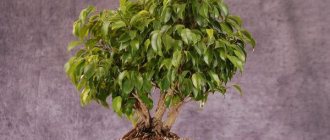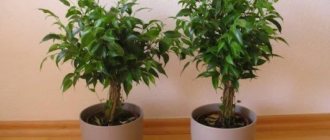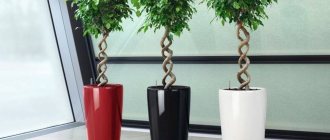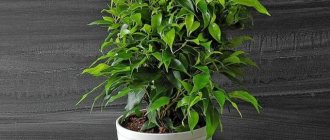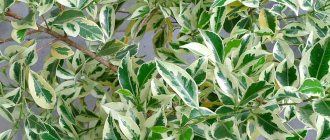Previously, in Soviet Russia, ficus trees were a sign of the bourgeoisie. Now this plant is treated completely differently. In Asian countries, where ficus comes from, it is given special importance. For example, if you give a ficus in China, it means that by default you wish the owner long life and prosperity. In Thailand, ficus is a symbol of the state capital. And in Sri Lanka there is a 150-year-old ficus, which is revered almost as a deity.
Oriental signs also say: if you give a ficus to a childless couple, and it takes root well and begins to grow rapidly, then soon a long-awaited baby will appear in the house.
“When buying ficus Benjamin, remember that it is small and compact only for the first 5 to 7 years,” warns the chairman of the Moscow Flower Growers club, Tatyana Zhashkova. – My ficus is already more than 20 years old, and it has already become a powerful, spreading tree with a voluminous trunk and a crown right up to the ceiling. So be prepared for the fact that over time your pet may require much more space.
Varieties of Ficus Benjamin
Ficus Benjamin (Ficus benjamina) is valued for its beautiful leaves - in species plants they are dark green, oval, 5 - 12 cm long and 2 - 5 cm wide (1). There are a lot of varieties of this ficus, which is not surprising - this plant is very popular among gardeners. And breeders, trying to satisfy requests, came up with very interesting options:
- Anastasia - with green leaves decorated with a light green border;
- Barok is a small-leaved variety whose leaves are twisted into a tube;
- Buklee - with leaves slightly curled inward;
- Wiandi is a small-leaved variety with green leaves and a curved trunk, making the plant look like a bonsai;
- Golden King - it has green leaves with a bright yellow stripe along the edge;
- Golden Monique - with light green-golden leaves, heavily corrugated along the edges, and dark green streaks along the central vein;
- Curly is a slow-growing variety with severely deformed leaves that are mostly white;
- Monique - with green corrugated leaves;
- Naomi - with dark green leaves, slightly wavy along the edges;
- Naomi Gold - its young leaves are light green with dark streaks in the middle, but with age they turn green;
- Samantha (Samantha) - with grayish-green leaves with a thin white stripe along the edge;
- Safari - a small-leaved variety with green leaves decorated with cream specks;
- Starlight - with mostly white leaves, very beautiful, but whimsical: at the slightest violation of care, its leaves fall off.
Ficus Benjamina Starlight. Photo: commons.wikimedia.org
Caring for Ficus Benjamin at home
Ficus Benjamin is generally unpretentious, but is sensitive to serious violations of agricultural practices. And it’s the rare varieties that are most often capricious.
Priming
The soil for Ficus Benjamin should be fertile, moisture-absorbing and breathable. You can buy soil for decorative foliage plants in the store, but it is useful to add turf soil, sand, and leaf humus.
Temperature
Ficus Benjamin is thermophilic - in summer it needs a temperature of 22 - 28 ° C, in winter a little lower - 12 - 16 ° C (2). If it gets cooler, the plant will shed its leaves. And he also hates drafts.
Lighting
This plant requires indirect light. Direct sunlight is contraindicated for it, so it has no place on the southern and eastern windowsill. On these cardinal points it is better to place it on the floor near the window. And on western and northern windows it may well grow on the windowsill.
But this applies to varieties with green leaves. If the leaves of your ficus are decorated with white strokes, spots or a neat border, then this plant needs more light in order for the color to be preserved. But still avoid direct sunlight so as not to burn the plant.
Humidity
Ficus benjamina categorically does not tolerate either drought or overwatering. If there is not enough moisture, the leaves begin to turn yellow and rapidly fall off. And if there is frequent stagnation of moisture in the pan, then the plant begins to hurt - the roots rot. Therefore, half an hour after watering, excess water is poured out of the pan.
Photo: pixabay.com
In winter, when the batteries are working, the plant needs to be sprayed more often than in summer. You can place a container of water next to the pot if you don’t have a humidifier. But in winter you can water less often - once a week or even once a week.
Fertilizers and fertilizers
In the summer, Ficus Benjamin is fed once every 2 weeks with complex fertilizer for decorative deciduous crops or specifically for ficus. In winter, fertilizing is also needed, but much less often - once every 6-7 weeks.
Trimming
Ficus grows quickly, young shoots are very flexible. And if they are not shortened in time, the plant will become excessively long. Therefore, it needs to be trimmed regularly. Moreover, the younger the tree, the better. It will be much more difficult to give shape to the grown, stiff giant.
Pruning is done in the spring, at the end of March - beginning of April. Moreover, they deal with ficus as with trees in the country - they shorten excessively long branches, cut out branches directed into the crown. In summer, trim or pinch shoots that stand out from the overall neat picture. Pruning and pinching stops at the end of September to preserve nutrients in the branches and leaves.
To prevent fungal diseases, the sections can be sprinkled with activated carbon or covered with garden pitch.
How to care after purchase
When purchasing, it is important to carefully examine the ficus, make sure that the soil is not over-moistened and does not emit an unpleasant odor. Choose a comfortable place for the plant: well-lit, warm and windproof.
Try not to move it from place to place often. It is advisable to spray the leaves and water the soil with Gumi-20 (2 drops per 200 ml) and quarantine for a week away from other flowers.
Replant no earlier than two weeks later to allow the flower to get used to the new conditions. If the plant does not get sick during this period, it is advisable to replant it, since store-bought soil is not intended for long-term cultivation.
After transplantation, you cannot use fertilizing for a month. Adjust watering: during the adaptation period, it is especially important not to overwater the ficus.
Don’t worry if you can’t perfectly comply with some conditions for caring for the plant: ficus benjamina is quite unpretentious and will forgive you for mistakes.
Reproduction of ficus benjamina at home
There are two ways to propagate ficus benjamina at home, and neither of them can be called easy.
By cuttings. It is not at all necessary to cut off only the top for this. Lateral layers are also suitable. But it is important to consider several nuances:
- the plant must be mature;
- the base of the future seedling should be semi-lignified, that is, still flexible, but no longer green (green cuttings will not take root, but will simply die), however, if there are only lignified branches, then there is a chance with them too;
- the stem-cutting should have from 4 to 6 unfolded leaves.
The milky juice on the cut should be washed well or removed with a napkin; the lower leaves can also be removed.
If only lignified branches are available, then you need to carefully cut the base into several parts with a sharp knife. To prevent the cuts from touching, you can place a match between them. In this way, we kind of form future roots and stimulate root formation.
Then the cuttings need to be placed in water, or planted in a light seedling substrate or in perlite. If you plant cuttings in the soil, set up something like a greenhouse, covering the top with either a plastic bag, a tall plastic glass, or a cut plastic bottle.
If the apartment is warm enough (not lower than 20 ° C), then roots will form within 2 to 3 weeks. When they become strong (in another couple of weeks), you can transplant the cuttings to a permanent place in the pot. For the first couple of weeks, you can still continue the greenhouse effect by covering the seedling, then remove it and send it on an “adult” voyage.
By layering. This option is suitable for an old adult plant that is reluctant to form young shoots, but is all covered with mature woody shoots.
Carefully, being careful not to touch the wood, make a ring-shaped cut on the bark of one of the shoots, carefully removing the top layer. Treat the exposed plant tissue with a growth stimulator and wrap it in moist sphagnum or a mixture based on it. Carefully secure the structure with film, firmly securing the edges with wire or tape.
After some time, the formed roots will become visible through the film. It must be carefully cut below the roots and planted in the usual way. The cut site on an adult plant must be treated with activated carbon or garden varnish.
Content
- Varieties of Ficus Benjamin
- Caring for ficus benjamina
- Reproduction of ficus benjamina
- Ficus crown formation
- Care video
These are evergreen shrubs and trees. In nature, they grow like our birches, about 20-25 meters in height; at home, ficus benjamina does not grow quickly and will reach 100-120 centimeters in height in about 10 years. Ficus has an invasive root system that spreads not only in depth, but also along the surface of the earth; the aerial roots of old plants growing in a humid tropical climate form entire arrays of supports under a wide spreading crown. Indoor ficus plants in pots have a fairly strong root system; over time, if soil is not added, the roots appear above the surface of the ground, but aerial roots do not form.
Ficus benjamina has dark gray bark with brown cross-striations. It branches very well, the shoots are drooping, the leaves are alternate, on short petioles, smooth, shiny, leathery, oblong (elliptical) or lanceolate, pointed at the end, 6-12 centimeters long and 3-6 centimeters wide. The fruits are syconia, about 1.5 centimeters in diameter, paired, axillary, red, burgundy when ripe, inedible. In indoor conditions, ficus benjamina does not bloom and, accordingly, does not bear fruit. When the petiole is broken, when the leaf is cut, the roots are trimmed, a sticky white milky juice is released.
Transplanting Ficus Benjamin at home
The younger the ficus, the more often it needs to be replanted, because the roots grow as rapidly as the branches. It is advisable to replant young plants (up to 7 years old) every year by transferring them into a slightly larger pot (about 2 - 3 cm larger in diameter, since the roots are actively growing).
Photo: pixabay.com
Older plants are replanted once every 2–3 years, or even less often. Make sure that the roots do not appear from the drainage hole - this will be a sign that the pot for your ficus is already too small.
If the plant is more than 12 years old, then instead of replanting, you can simply replace the layer of top substrate.
Ficus benjamina diseases
This type of ficus is susceptible to diseases, so it is important to recognize them as early as possible in order to begin timely treatment.
Root rot. If the roots of a ficus are rotten, the leaves very quickly begin to turn yellow, then darken and fall off. And the cause of this disease is usually waterlogging of the soil.
Root rot can only be treated in its early stages. You need to remove the affected plant, cut off all the rotten roots, wash the roots in a weak solution of potassium permanganate, dry them, and then plant them in a new pot with fresh soil.
If the damage is severe, the plant cannot be saved. But you can take cuttings from it and try to root them.
Anthracnose. Signs of this fungal disease are brown spots on the leaves. Gradually they grow and become like ulcers. Leaves fall. With severe damage, the plant dies.
The drugs Fitosporin or Alirin are suitable for the treatment of this disease (3).
Cercospora blight. This is also a fungal disease, and its first symptoms appear on the underside of the leaves - these are black spots. A diseased plant's leaves begin to turn yellow and fall off, which can lead to its death.
This disease can be cured with the same drugs that are used to treat anthracnose - Fitosporin and Alirin (3).
Crown trimming
Depending on the purpose, pruning can be divided into several types, each of which has its own characteristics.
These include:
- Formative - it is recommended to carry out in early spring, before the period of active growth. Before carrying out it is necessary to prepare sharpened pruning shears, activated carbon and a solution of potassium permanganate for processing cuts and pruning shears. Thick sprouts need to be cut at an angle, thin ones by a third;
- Rejuvenating - necessary to renew the flower. It is recommended to start in early spring before the start of the growing season. All dry branches must be removed and live ones cut in half. If the ficus has dried completely, it is recommended to cut it off completely, leaving only a stump no more than ten centimeters in height;
- Sanitary - carried out without reference to a specific time, depending on the need. Aimed at removing diseased, dry and poorly developed branches. If you find branches affected by fungus, you should not wait, but cut off the damaged branches immediately.
- Formative and sanitary pruning is recommended to be carried out annually. This will help keep the flower vigorous for a long time.
Popular questions and answers
We talked about the problems in growing Ficus Benjamin with agronomist-breeder Svetlana Mikhailova.
Where is the homeland of Ficus Benjamin?
This ficus has a fairly wide habitat. It grows in tropical areas of Asia - India, China, Indonesia, the Philippines and northern Australia.
How to choose Ficus Benjamin?
The main thing is that the plant is healthy - without spots on the leaves and bare shoots, which may indicate leaf fall. If possible, remove the plant from the pot and inspect the roots - they should be healthy and free of rot. And remember that varieties with unusual leaf colors are more whimsical; they often do not forgive mistakes in care.
Why do ficus benjamina leaves fall?
The main reasons are lack of light, lack of moisture or, on the contrary, excessive watering, drafts, diseases and pests. To cope with the problem, you need to adjust the care or treat the plant.
Why do the leaves of Ficus Benjamin turn yellow?
The reasons are the same as those that cause leaves to fall off - improper watering, a bad place where the ficus grows (it may not have enough light), drafts, diseases and pests.
To prevent this from happening, it is important to find a suitable place for the ficus, follow the care recommendations and treat it on time. Sources
- Visyashcheva L.V., Sokolova T.A. Industrial floriculture. Textbook for technical schools // M.: Agropromizdat, 1991 – 368 p.
- Tulintsev V.G. Floriculture with the basics of selection and seed production // Stroyizdat, Leningrad branch, 1977 - 208 p.
- State catalog of pesticides and agrochemicals approved for use on the territory of the Russian Federation as of July 6, 2022 // Ministry of Agriculture of the Russian Federation, https://mcx.gov.ru/ministry/departments/departament-rastenievodstva-mekhanizatsii-khimizatsii -i-zashchity-rasteniy/industry-information/info-gosudarstvennaya-usluga-po-gosudarstvennoy-registratsii-pestitsidov-i-agrokhimikatov/
Options for trunk formation
Not only the crown, but also the trunk can be shaped. This property is due to its high flexibility, which allows it to be woven into three-dimensional structures. For greater effect, it is recommended to place several containers nearby and work with the shoots of several plants at once.
It is recommended to start forming a trunk after the young shoots reach at least 20 cm in height. It is at this moment that you need to make the first bend for the future structure.
To prevent the shoot from returning to the initial direction of growth, it must be secured with a cord. Subsequently, the shoot slowly bends into the desired shape in the same way.
Let's watch a video about the formation of the trunk:
But not only the cord will help in shaping the trunk. Another method is splicing shoots, which is used in the formation of hedges. To do this, it is necessary to cut the bark of neighboring sprouts and tie them together for fusion.

